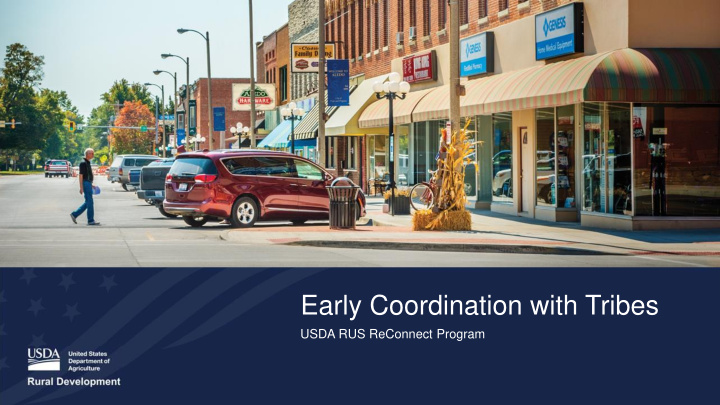



Early Coordination with Tribes USDA RUS ReConnect Program
Chris Proctor Management & Program Analyst USDA Rural Development 2
Agenda • Introduction to RD: Structure and Roles • Introduction to Indian Country and Tribal Lands • Additional Regulatory Requirements • Recommendations • Additional Resources 3
Introduction to RD: Structure and Roles OneRD – Three Agencies Leadership • Under Secretary • Deputy Under Secretary Rural Development • Administrators • State Directors Offices Rural Business- Rural Housing Service Rural Utilities Service • 47 State Offices Cooperative Service • 400 Area Offices • National Office in DC Telecom Business Single Family Electric Cooperative Multi Family Water & Energy Community Facilities Environmental 4
Introduction to Indian Country and Tribal Lands Tribal Nations - Precontact 5
Introduction to Indian Country and Tribal Lands 2010 Census AI/AN in Alaska Wall Map 6
Introduction to Indian Country and Tribal Lands 2010 Census AI/AN in the U.S. Wall Map 7
Multiple Tribal Stakeholders Within Every Tribe • Elected Tribal Leaders • Tribal Historic Preservation Office • Tribal IT Department • Tribal Economic Development Staff • Tribal Utility Staff • Other Tribal Programs (Natural Resources, Land Management, etc.) • Tribal Members Don’t assume a signed letter or communication with one person from a Tribe means that all the other tribal parties are fully informed of your project or supportive of it. 8
Additional Regulatory Requirements Regardless of whether or not you are proposing to cross tribal lands, as soon as you accept funds from Rural Development you must comply with the National Environmental Policy Act (NEPA) and RD’s implementing regulations prior to drawing down funds and prior to construction. • Includes compliance with Section 106 of the National Historic Preservation Act and requirement for RD to consult with Tribes • BIA Rights of Way Regulations when crossing tribal lands • https://www.bia.gov/as-ia/raca/rights-way-25-cfr-169 • Other potential challenges 9
Additional Regulatory Requirements “The National Historic Preservation Act (NHPA) requires federal agencies, in carrying out the Section 106 process, to consult with Indian tribes and Native Hawaiian organizations (NHOs) when historic properties of religious and cultural significance to them may be affected by a project that they carry out, license, or financially assist (also referred to as an undertaking). The ACHP’s regulations implementing Section 106, 36 C.F.R. Part 800, in turn, require federal agencies to consult with Indian tribes and NHOs throughout the review process for such projects. This requirement applies regardless of the location of the historic property.” From Early Coordination With Indian Tribes During Pre-application Processes – A Handbook. Published by the ACHP 10
Recommendations • Utilize RD staff expertise • Understand the land tenure of proposed service territory • Start building relationship of mutual trust and respect as soon as possible • Approach Tribes with respect as partners, custodians of a unique cultural heritage, landowners and sovereign nations • Be prepared to work with BIA and tribal land management staff if your project will cross tribal lands 11
Resources Advisory Council on Historic Preservation (ACHP) • On-line Training Resources • https://www.achp.gov/training/elearning • Early Coordination Handbook • www.achp.gov/sites/default/files/documents/2019-10/EarlyCoordinationHandbook_102819_highRes.pdf Department of Housing and Urban Development (HUD) • Tribal Directory Assessment Tool - https://egis.hud.gov/TDAT/ USDA Rural Development Regulations & Guidance • PART 1970 — ENVIRONMENTAL POLICIES AND PROCEDURES • https://www.ecfr.gov/cgi-bin/text-idx?SID=2d8457de87c022d0e240337e369f665f&mc=true&node=pt7.14.1970&rgn=div5 • Subpart H - Historic and Cultural Resources Instruction • https://www.rd.usda.gov/sites/default/files/1970h.pdf 12
14
End Slide
Recommend
More recommend